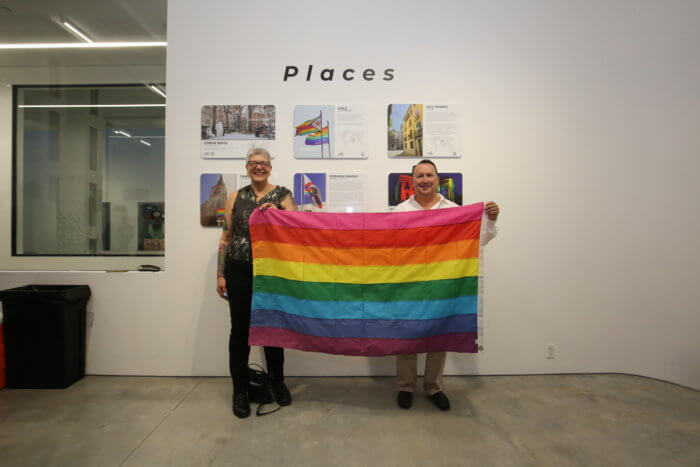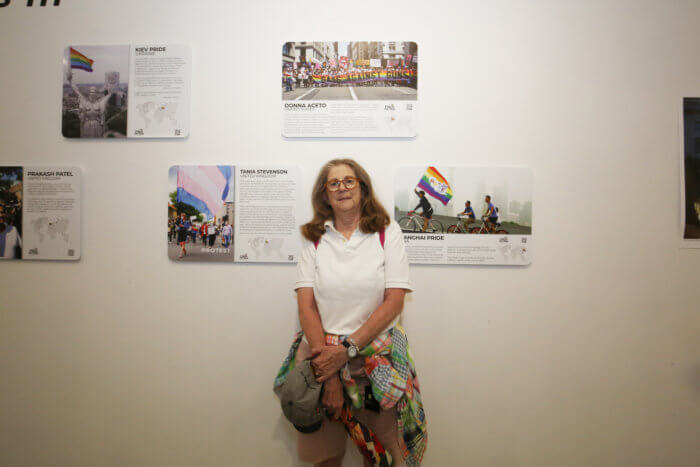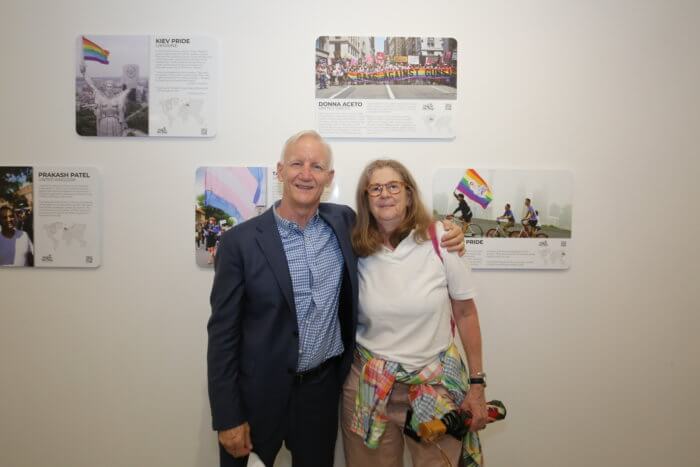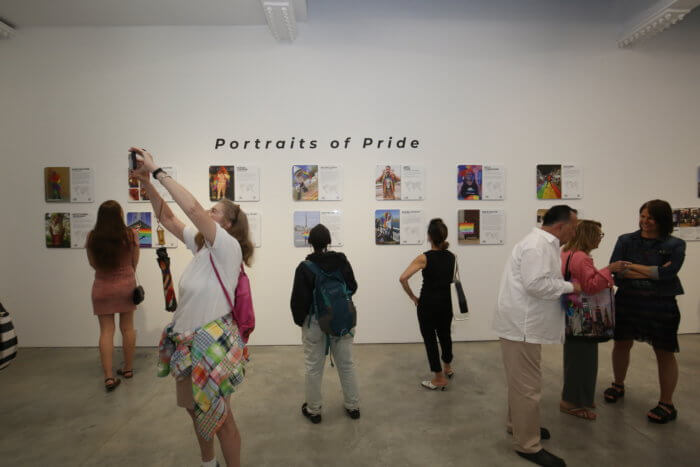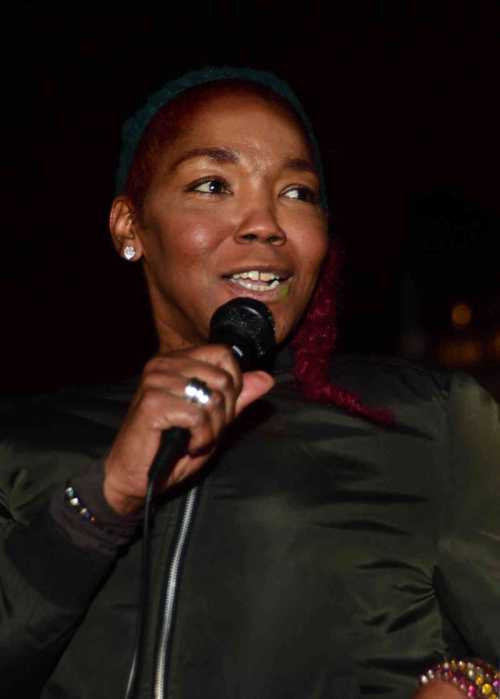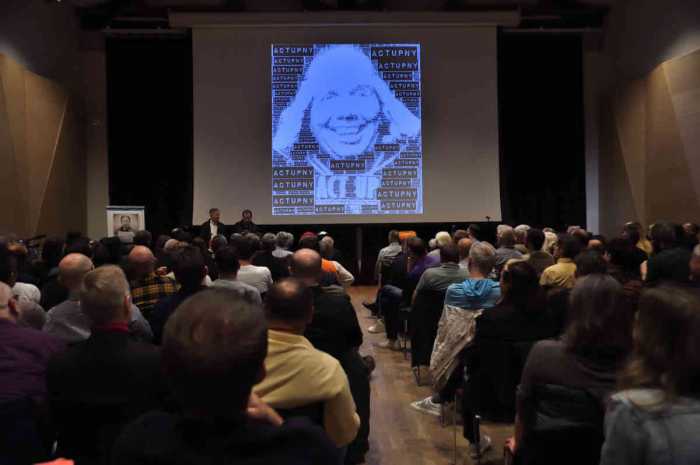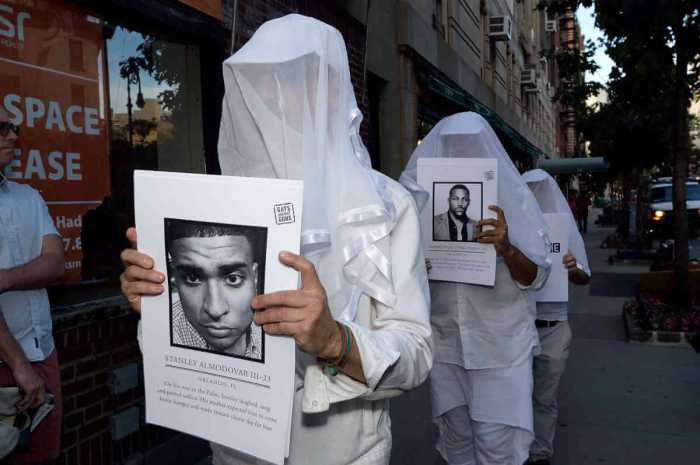Since its 1970s creation, the late Gilbert Baker’s Rainbow Flag has become a universal symbol of the LGBTQ rights movement. Its colors have lit the White House, flown over suburban office parks, and even stamped as marketing tool on products as quotidian as laundry detergent.
What the flag means to individuals — in the United States and especially abroad — is the subject of Flag in the Map, a special traveling and online exhibition with an accompanying book. The exhibition is a partnership between the United States-based Gilbert Baker Foundation, which continues the work of the artist who died on March 31, 2017, and British organization ReportOut, which documents the experiences of sexual and gender minorities across the globe. Images of the Rainbow Flag and its meaning to the photographers and subjects make up the exhibition, which has contributions from the Unites States and more than 40 other countries, including Ukraine, Brazil, Singapore, Pakistan, Cuba, and Kenya.
Flag in the Map launched in New York City on Thursday, June 2, during a one-night show at Chelsea’s High Line Nine Galleries. Photographs were grouped into five categories: Families & Friends, Places, Portraits of Pride, Celebrations, and Activism.
According to Charley Beal, Gilbert Baker Foundation President, hundreds of submissions were received from around 60 countries before finalizing the 46 displayed images. The exhibition is designed so that any organization, center, or group can present it within their own designated space.
Beal highlighted submissions that demonstrated dangers for LGBTQ people in other countries.
“My favorite of all is this one from Shanghai,” he told Gay City News. “These young kids went out early in the morning because they were afraid of getting arrested” as they bicycled with the Rainbow Flag.
Another striking image came from Kenya’s Kakuma Refugee Camp, submitted by Mbariza Moses. According to Beal, they “organized the first Pride parade at the Kakuma refugee camp in 2018. This is the largest refugee camp in the world.” Activists “were attacked, beaten, their flags were confiscated,” Beal explained. A few people from the image gained asylum in other countries.
With Ukraine on the radar because of the Russian invasion, Beal pointed out a striking image from Kyiv, of the Rainbow Flag in front of the Soviet-era Motherland Monument. The photo was by Ruslan Beliaiev and is a trick of the eye. One drone held a camera, photographing the Rainbow Flag, carried by another drone, to appear as if attached to the statue’s sword.
“It’s really given the middle finger to Vladimir Putin, who has vowed to wipe the LGBTQ presence out of Ukraine,” Beal said.
A special guest at the opening was Monica Helms, creator of the pink, white and blue Trans Flag.
“I think that this is an amazing display,” Helms said. “I am so proud to be part of this organization.”
She further reflected on Baker, commenting, “Gilbert and I had similar things in life. We were both veterans. And he was born the same year I was born. So, you know, I’m very happy to be part of this organization and to help them whenever I can.”
Many activists were at the event, including Gilbert Baker Foundation board member Cathy Marino-Thomas, who said she had chosen many of the photographs and that the exhibition represents the “culmination of many years of our work and Gilbert’s work, to get the Pride Flags to become a symbol of hope and a beacon of togetherness for our community. To see what it means to other people around the world has been very inspiring.”
Irish-born activist and filmmaker Brendan Fay, a founder of the St. Pat’s for All parade, also reflected on Baker’s impact.
“I’m so moved and inspired walking around here,” Fay said. “It’s reminding me of just that simple phrase, ‘one person can make a difference.’ I’m very moved by his spirit of generosity, that he always said, the Rainbow Flag belongs to the people. And this is what is on display.”
The internationality of the flag also struck Fay. Despite dangers in various countries, he said communities across the world have embraced “a symbol, which is a symbol of empowerment, hope, liberation, and freedom,” despite the danger of being “arrested, beaten, and tortured.” Yet, even in the United States, he said there was an irony that it was not until 2022 that the Rainbow Flag was first officially raised on federal property, at the Stonewall Monument the day before.
The exhibit highlighted American photographers like Daniel Nicoletta, who worked with Harvey Milk at his camera store in the Castro District of San Francisco, and Donna Aceto, who contributed an image of Gay Against Guns at the 2016 New York City Pride March following the mass shooting at the Pulse nightclub in Orlando, Florida, where 49 patrons were murdered.
Aceto, whose work often appears in Gay City News, explained, “I’m thrilled to have this photo in primarily because of what it is.” She added, “I’m very involved with Gays Against Guns, and that photo was taken right after Pulse at the first Pride after Pulse.” She added, “it’s nice not only to have a record of it, but to have other people know exactly what happened and to see it.”
Texas native Stephen Sunday, who now lives in Florida, submitted an image of the Rainbow Flag flying over West Palm Beach City Hall as a result of his request to the mayor. In his explanation accompanying the image, Sunday writes of how people would spit on him at parades of the past — particularly during the height of the AIDS epidemic. Sunday believes things have changed, and the Rainbow Flag represents that.
“The most important word to me that describes the Rainbow Flag is love,” Sunday told Gay City News. “There are other words, but the most powerful is love.”
The exhibit will also be shown at London’s Old Street Gallery on June 24, before traveling to Northern England, San Francisco, Paris and other locations throughout 2022-2023. Images are also online at https://gilbertbaker.com/flaginthemap.
“It still amazes me — as much as I see the flag all over the world,” Helms said. “There’s one place I still want to see it: The International Space Station. You know, during Pride Month — [that] would be a great time for them to show that in the Rainbow Flag up there.”
